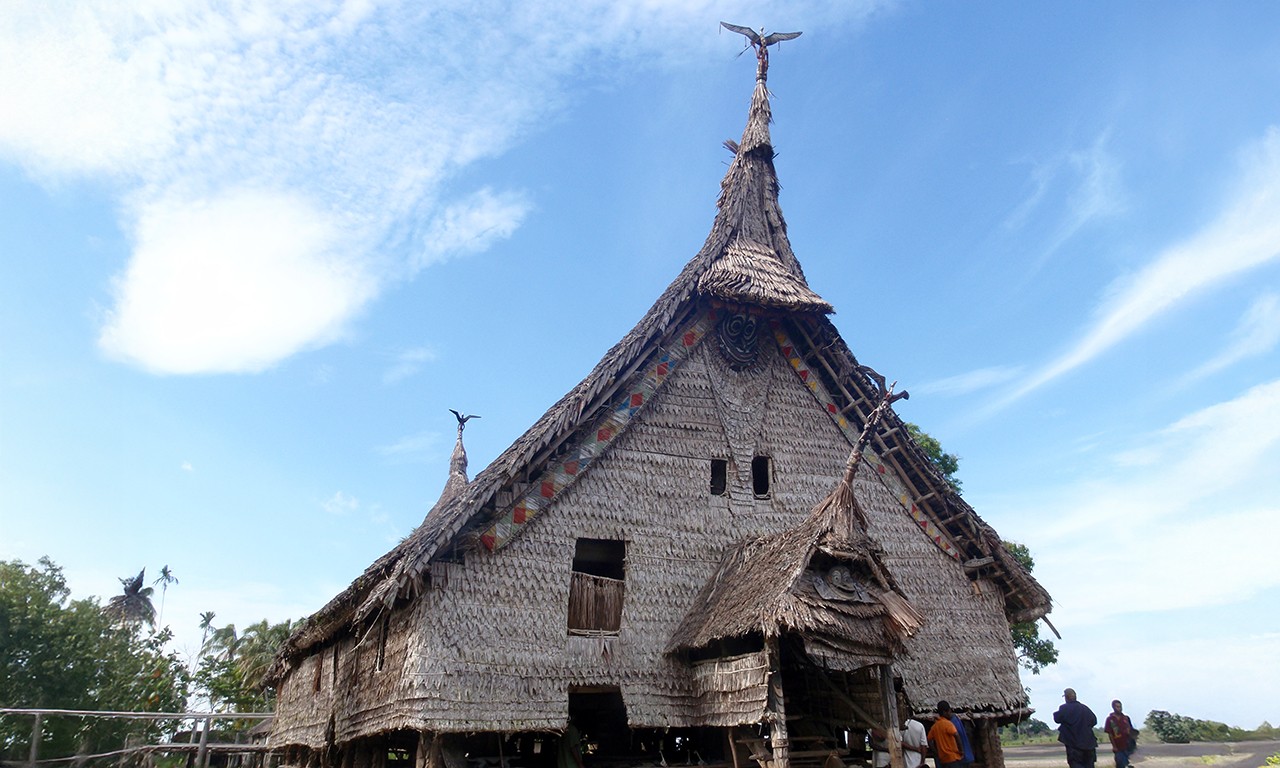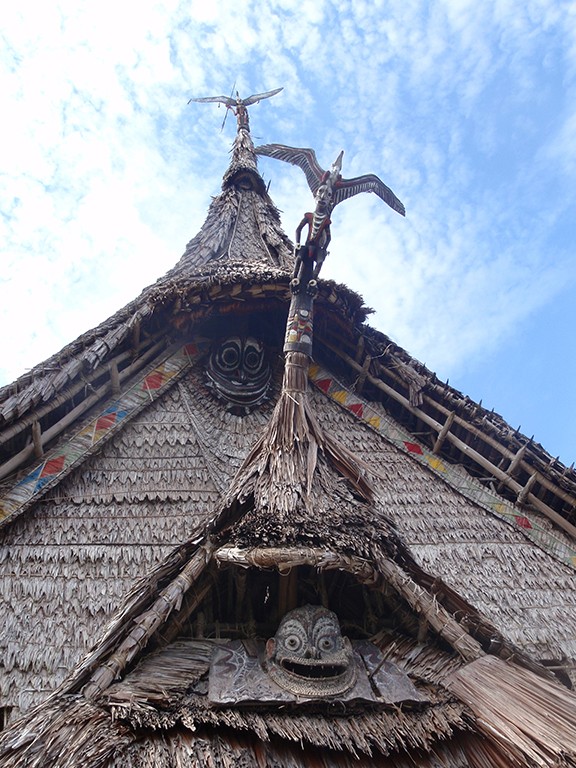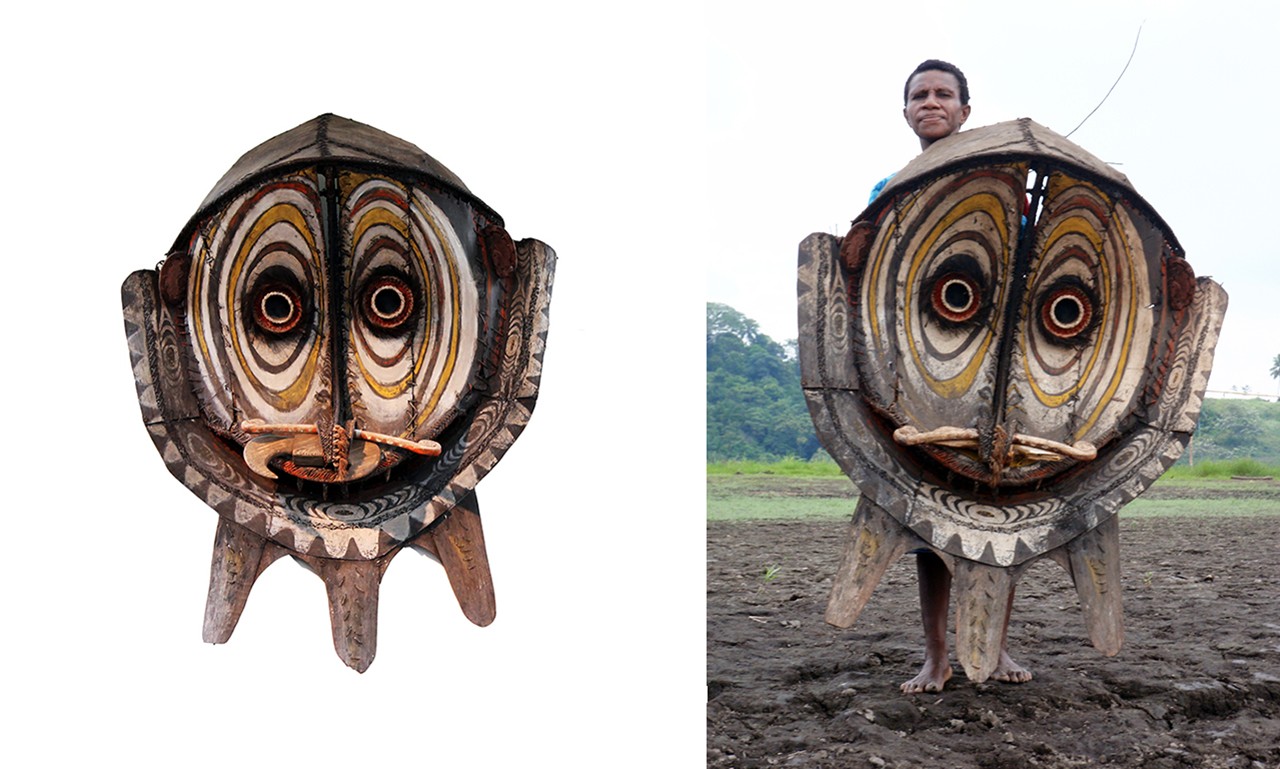 |
| Photograph of a haus tambaran taken by Peter and Signe Keller on a trip to Papua New Guinea in 2010 |
Bowers Museum is pleased to announce the newly reimagined John M. Lee Court, and in observance of Asian American & Pacific Islander Heritage Month in May, the occasion presents a timely opportunity to discuss select objects in the space from our Art of the Pacific collection that deserve a spotlight. Many familiar objects have been thoughtfully rearranged with their historical context, accessibility, and preservation in mind. It is our hope to breathe new life into these objects with this Bowers Blog serving as your guide to the remarkable examples of Melanesian heritage in the John M. Lee Court.
 |
Ceremonial House Lintel
20th century
Abelam culture
Sepik River region, East Sepik Province, Papua New Guinea, Melanesia
Wood, 17 × 168 × 6 in.
Gift in Memory of George Clayton Kennedy, 81.101.3 |
Lintel Things Mean a Lot
Men’s ceremonial houses (haus tambaran) found at the center of Sepik River villages serve as the venue for many important male ritual rites. The way they are built and ornamented varies distinctly by region—but typically consists of a raised platform and a steeply pitched, trussed roof supported by a series of columns. They are the most sacred structures within Sepik River villages distinguished by their monumental size and elaborate ornamentation. Haus tambaran were, and continue to be, the primary site where painting and sculpture are housed within these communities. Intricate, hung ceiling paintings, ancestor sculptures, monumental and vibrantly painted slit gongs, as well as clan treasures, are among the many traditional arts found within the immersive visual environments. Consequently, the haus tambaran is considered a major work of art in and of itself, as well as a source of communal pride.
 |
| Photograph of a haus tambaran taken by Peter and Signe Keller on a trip to Papua New Guinea in 2010 |
Men’s ceremonial house lintels, such as the remarkable example soon to return to display in the John M. Lee Court, are potent spiritual conduits packed with meaning and magic. The carvings portray powerful Abelam ancestral spirits, nggwal, as either stylized medallions or as full figures, alternating sequentially with crocodiles, which are deeply symbolic within the indigenous creation myth—according to which the island was believed to have been raised from the primordial waters by a mythological crocodile. Auspicious snakes line the top and bottom edges, while at each end, the hornbill signifies male strength and virility. Based on the high-quality craftsmanship and complexity of the carvings, it is unlikely that this particular object would have served a weight-bearing function, suggesting the lintel’s principally symbolic denomination.
 |
Gable Mask
20th century
Blackwater River, East Sepik Province, Papua New Guinea, Melanesia
Fiber, wood, shell, and pigment, 54 x 38 x 24 in.
Loan courtesy of Gayle and Edward P. Roski, L.2013.4.1 |
Photograph of a man holding L.2013.4.1 taken by Peter and Signe Keller on a trip to Papua New Guinea in 2010 |
The Feminine Face of Male Ritual
As you might find hanging high on the exterior of haus tambaran along the East Sepik River, the gable mask displayed in the John M. Lee Court can be viewed high above the threshold of the Anderson-Hsu-Tu Gallery. The elaborate mask features a distinctive broad, oval face with bold, concentric patterns in alternating pigments of white, black, yellow, and red that emphasize the deeply set eyes and intense gaze. The nose is indicated by carved wooden piercings made to resemble a bone and a fishhook, and merges seamlessly with the central ridge—symmetrically bifurcating the face. The mouth, which is framed by the underside of the interior concave panels, where stylized spikes depict teeth, culminates in a prominent ridge, representing the jaw, adorned with geometric and curvilinear motifs—terminating at the bottom in three prongs.
Although most Sepik traditions forbid women from entering haus tambaran, the ceremonial structures, are interestingly, conceived as embodiments of the primordial female. Thus, all things pertaining to men and to magic, traditionally taboo to women, in fact, take place figuratively inside of a female body. Extending this analogy— the façade represents the face of the primordial female, the architectural framework constitutes her body, and the gable mask embodies her specific mythological attributes.
As it would be highly specious to presume that iconography would carry the same meaning across Sepik cultures, never mind a gable mask made for a haus tambaran—any attempt to identify the specific mythical woman embodied by the gable mask would prove at best, to be tenuous. More readily discernable, is how it may have functioned. Its installation above the threshold beckons to the gable mask’s traditional apotropaic function and aligns with a broader architectural logic wherein elevation was employed to emphasize the perceived spirituality of a structure. This is observed across cultures, such as in the monumental architecture of the Christian tradition that feature high-vaulted cathedral ceilings designed to inspire a sense of awe and grandeur in the viewer. Further, it can be inferred that Sepik women, indeed, enjoyed respect and authority within their communities’ socio-ceremonial fabric in such a way that fundamentally differed from western notions of gender equality and binary roles. So to speak, the focus on male-ritual observed across many Sepik cultures does not necessarily indicate those practices to be inherently patriarchal, as the word has been conceived in various western contexts. We are reminded that exercising such perspective is always of utmost importance when viewing cultural objects, especially those from the vast diversity and complexity of ceremonies and artistic traditions belonging to the cultures along the Sepik River.
Text and images may be under copyright. Please contact Collection Department for permission to use. References are available on request. Information subject to change upon further research.





Comments